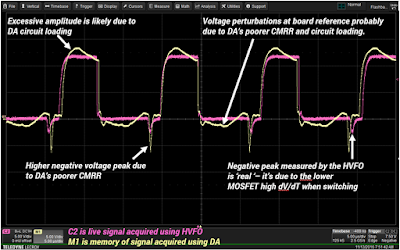 |
| Figure 1. Response of two different probes to an upper-side gate drive measurement. |
You are probably aware that all measuring instruments, including oscilloscopes, are subject to conditions of observability. As we discussed in a recent post on The Impact of the Interconnect, the very act of connecting the oscilloscope to the circuit with a particular probe affects the measurement in a particular way. Probes affect the circuit by applying additional resistance and capacitance loads in parallel with the circuit at the test point. Moreover, the probes themselves limit the fidelity of the measurement due to limits of bandwidth, slew rate and common mode response. So, it is always a good idea when making a measurement to compare how different probes/interconnects will affect the measurement…but don’t try to do it all at once.


